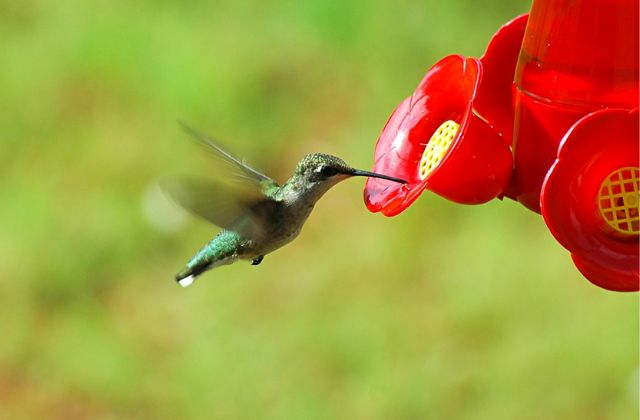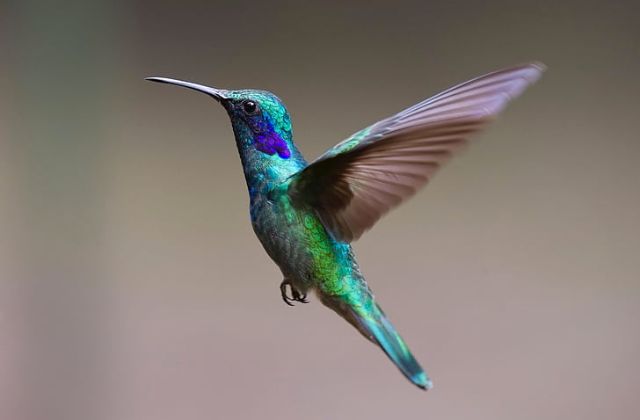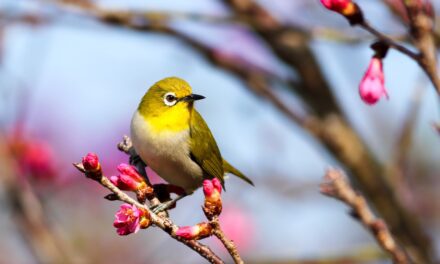How far do hummingbirds fly without eating or drinking? Hummingbirds, marvels of the avian world, captivate us with their vibrant feathers, rapid wings, and ability to hover in mid-air. In this article, we will explore the remarkable abilities of hummingbirds and discover just how far they can journey on empty stomachs.
Key Takeaways
- Hummingbirds have remarkable flight capabilities that allow them to cover vast distances, thanks to their high-energy requirements and efficient metabolism.
- Nectar is a crucial source of energy for hummingbirds, particularly during migration, when finding food sources can be challenging.
- Water is essential for their survival, and hummingbirds obtain it from various sources, including nectar, dew, and water droplets.
- Threats to hummingbirds during migration include predators, collisions with structures, competition for food resources, and habitat loss due to human activities and climate change.
- Understanding and conserving the unique adaptations of hummingbirds are vital for ensuring their long-term survival and the preservation of their migratory patterns. Further research and conservation efforts are necessary to protect these magnificent creatures.
Migration and Energy
Energy requirements for hummingbirds
Hummingbirds are incredible creatures with high energy demands due to their small size and rapid metabolism. These tiny birds require a tremendous amount of energy to support their migratory journeys. The energy requirements for hummingbirds can vary based on factors such as age, sex, weather conditions, and the distance they need to travel.
Migration patterns of hummingbirds
Hummingbird migration is a remarkable phenomenon that varies among different species. While some hummingbirds are known to be sedentary and remain in their breeding territories year-round, many species embark on long-distance migrations. These migrations can span hundreds or even thousands of miles, taking hummingbirds across various habitats and ecosystems.
Duration of migration
The duration of hummingbird migration can vary depending on the species and the distance they need to traverse. Some hummingbirds undertake relatively short migrations that last a few weeks, while others engage in more extended journeys lasting several months. The timing of migration is often influenced by seasonal changes, availability of food resources, and favorable weather conditions.
Energy Reserves of Hummingbirds
Fat stores of hummingbirds
Hummingbirds accumulate fat stores to provide the energy needed for their migratory flights. These tiny birds can double their body weight by putting on fat before embarking on their journey. This extra weight in the form of fat reserves serves as a crucial energy source that sustains them during long flights when they may not have access to abundant food sources.
Metabolic rates during flight
During flight, hummingbirds maintain high metabolic rates to support their energy-intensive activities. Their rapid wing beats, which can range from 50 to 200 beats per second, require a significant amount of energy. Hummingbirds have evolved a highly efficient metabolism that allows them to rapidly convert the energy from nectar into the fuel needed for their continuous flight.
Energy conservation techniques
To conserve energy during migration, hummingbirds adopt various techniques. They utilize a phenomenon called torpor, where they enter a state of reduced physiological activity during periods of low energy availability. This torpor helps minimize their energy expenditure by lowering their body temperature and reducing their metabolic rate. By conserving energy through torpor, hummingbirds can conserve their limited fat reserves and use them judiciously during their long flights.
Flight Capabilities of Hummingbirds
Hovering capabilities
One of the most impressive flight capabilities of hummingbirds is their ability to hover in mid-air. Hummingbirds can maintain a stationary position by rapidly flapping their wings in a figure-eight pattern, creating lift and countering the force of gravity. This unique hovering ability allows them to extract nectar from flowers while maintaining a stable position in the air.
Lift, speed, and endurance
Despite their small size, hummingbirds possess remarkable lift, speed, and endurance. Their rapid wing beats generate enough lift to keep them airborne and enable them to fly forward, backward, and even upside down. Hummingbirds have been recorded flying at speeds of up to 34 miles per hour, making them one of the fastest birds in the world. Additionally, their efficient flight mechanics and metabolism enable them to sustain continuous flight for extended periods without fatigue.
Wing morphology and flight performance
The wing morphology of hummingbirds plays a crucial role in their flight performance. Their wings are relatively long and narrow, allowing for efficient wing beats and maneuverability. The shape of their wings, combined with their rapid wing flapping, produces a vortex that generates lift and thrust. This unique wing design enables hummingbirds to perform intricate aerial maneuvers and achieve impressive flight capabilities.

Efficiency in Aerodynamics
Energy-efficient flight techniques
Hummingbirds employ energy-efficient flight techniques to optimize their long-distance flights. They utilize tailwinds and updrafts to reduce their energy expenditure by taking advantage of favorable air currents. By riding these air currents, hummingbirds can conserve their energy and cover greater distances with less effort.
Adaptations for long-distance flights
To adapt to long-distance flights, hummingbirds have developed structural and physiological adaptations. They possess a high muscle-to-body mass ratio, allowing them to sustain the rapid wing beats necessary for continuous flight. Additionally, hummingbirds have a unique shoulder joint that enables them to rotate their wings in a wide range of motion, enhancing their agility and flight performance.
Wingbeat frequency and amplitude
The wingbeat frequency and amplitude of hummingbirds are critical factors in their flight efficiency. Hummingbirds have the remarkable ability to adjust their wingbeat frequency and amplitude based on flight conditions, such as wind speed and direction. This flexibility allows them to optimize their flight performance by balancing the energy expenditure required for lift and thrust.
Hummingbirds’ Feeding Habits
Caloric intake for hummingbirds
Hummingbirds have high caloric requirements due to their active lifestyle and energy-intensive flight. They predominantly feed on nectar from flowers, which provides them with the necessary sugars and carbohydrates for energy. To sustain their high metabolic rates, hummingbirds need to consume large amounts of nectar, often exceeding their body weight in nectar daily.
Feeding strategies during migration
During migration, hummingbirds face challenges in finding reliable food sources along their migration routes. To overcome this, they adopt various feeding strategies. They rely on nectar-producing flowers, strategically timing their migration to coincide with peak flower blooms. In addition to nectar, hummingbirds consume small insects and spiders, which serve as protein-rich supplements to their diet during migration.
Importance of nectar for energy
Nectar is a vital source of energy for hummingbirds, particularly during migration. It provides them with the high sugar content required to fuel their continuous flight, allowing them to cover vast distances. The energy-rich nectar offers rapid fuel replenishment, helping hummingbirds sustain their intense metabolic activities and support their migratory journeys.

Water Requirements for Hummingbirds
Water intake and needs
In addition to their energy requirements, hummingbirds also have water requirements to maintain proper physiological functioning. While nectar provides some moisture, hummingbirds need additional water intake for hydration. They obtain water primarily through their diet, including nectar, dew, and small insects. The intake of water is vital for maintaining their body temperature, preventing dehydration, and ensuring overall survival.
Water sources for hummingbirds
Hummingbirds acquire water from various sources depending on their habitat and availability. They often obtain water from rain, dew, and shallow pools. Additionally, hummingbirds are known to take advantage of water droplets on leaves or flowers, using their long, specialized tongues to lap up the water. These diverse water sources are critical for hummingbirds, especially during their demanding migratory journeys.
Water conservation techniques
Considering the scarcity of water sources along their migration routes, hummingbirds have developed water conservation techniques. One such technique is reducing water loss through respiration. Hummingbirds have highly efficient respiratory systems that enable them to extract a significant amount of moisture from their exhaled breath, minimizing the loss of valuable water during exhalation.
Seasonal and Environmental Factors
Effects of weather on migration
Seasonal and environmental factors, particularly weather conditions, significantly influence hummingbird migration. Favorable winds, mild temperatures, and clear skies create optimal conditions for their long flights. Strong headwinds, storms, or extreme temperatures can hinder or delay their migration, forcing them to seek shelter and postpone their journeys until weather conditions improve.
Timing of migration and flower availability
The timing of hummingbird migration is closely linked to the availability of food resources, specifically nectar-producing flowers. Hummingbirds time their migration to coincide with the peak bloom of flowers along their migratory routes. This synchrony ensures that they have a sufficient food supply to meet their energy needs during their demanding journeys.
Availability of food and water sources
The availability of food and water sources greatly influences hummingbird migration. The presence of suitable flowers and water bodies along their migration routes plays a crucial role in their survival. Habitat loss and degradation, as well as climate change, directly impact the availability of these resources, making it challenging for hummingbirds to find adequate nourishment during their migration.
Threats and Challenges During Migration
Predators and hazards during flight
Hummingbirds face numerous threats and hazards during their migratory flights. Predators, including larger birds and mammals, pose a significant risk to these tiny birds. Additionally, collisions with human-made structures such as windows, buildings, and communication towers are also a major threat. These hazards, combined with the challenges of finding food and water sources, make migration a perilous journey for hummingbirds.
Competition for food resources
Competition for food resources is another challenge hummingbirds encounter during migration. As they traverse various habitats and ecosystems, they may encounter other bird species and insects that rely on nectar-producing flowers. The limited availability of flowers during migration can lead to intense competition and resource scarcity for hummingbirds, affecting their ability to meet their energy requirements.
Effects of habitat loss on migration
Habitat loss and degradation significantly impact hummingbird migration. The destruction of crucial breeding, foraging, and resting habitats along their migration routes disrupts their natural rhythms and reduces the availability of necessary food and water sources. The loss of suitable habitats due to deforestation, urbanization, agricultural practices, and climate change poses long-term threats to hummingbird populations and their migratory patterns.
Exceptions to the Rule
Hummingbirds capable of long flights
While most hummingbird species undertake relatively short to moderate migrations, some species are capable of more extended flights. The Rufous Hummingbird (Selasphorus rufus), for example, is known for its remarkable long-distance migration. These birds travel from their breeding grounds in North America to wintering areas in Mexico, spanning approximately 2,000 miles. These exceptional migratory capabilities highlight the diversity within the hummingbird family.
Impact of size and species on flight duration
The size and species of hummingbirds can influence their flight duration without eating or drinking. Smaller species with higher metabolic rates and faster wing beats generally have shorter flight ranges without food or water. Larger species, on the other hand, may be able to sustain longer flights due to their larger energy reserves and lower metabolic rates. However, the specific physiological adaptations and environmental conditions also play significant roles in determining their flight duration capabilities.
Rare cases of extended fasting
While hummingbirds heavily rely on their energy reserves during migration, there have been rare cases of extended fasting. Some individuals may be forced to go without eating or drinking for several days due to unfavorable conditions or low food availability. These cases of extended fasting highlight the resilience and adaptability of hummingbirds to overcome challenging circumstances during their arduous migration journeys.
Other Posts You Might be interested in
- Why Do Some Birds Hop While Some of Them Walk
- Why Do Owls Hoot 3 Times Meaning
- How Long Do Cardinal Eggs Take To Hatch?
- Why Do Birds Eat Rocks?
Conclusion
Hummingbirds’ migratory journeys are impressive feats of endurance and adaptability. These tiny birds embark on long-distance flights, fueled by their high-energy requirements and efficient flight capabilities. Their ability to accumulate fat stores, adjust metabolic rates, and employ energy-saving techniques allows them to undertake these demanding journeys.
However, threats such as predators, competition for resources, and habitat loss pose significant challenges to their survival. Understanding the energy, flight, feeding, and water requirements of hummingbirds is crucial for their conservation and the preservation of their migratory patterns.




